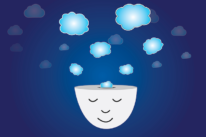
“If we do not feel grateful for what we already have, what makes us think we’d be happy with more?” ~Unknown
From time to time during my schooling years I’d be asked to identify my role models. I always chose someone who’d changed the world in a big way—Martin Luther King Jnr, Nelson Mandela, Mahatma Gandhi.
I never looked within my own life for role models. I had lovely parents and great teachers, and still, I was always looking well beyond what was right in front of me. I was always striving for something more, out there, beyond my own life.
As I reflect back, I see the dissatisfaction that this bred. I see how little I valued myself and by extension, my immediate surroundings. Somehow it all seemed… not good enough.
People and experiences that were far away from my hometown seemed so much more important and exciting.
It wasn’t until I started keeping a gratitude journal that this really began to change. I started the journal because I was depressed. Not sad—can’t-get-out-of-bed-or-even-talk-to-anyone depressed.
It would hit me on and off over the years, and the only coping mechanism I had at the time was to hide in my bedroom and breathe through the long and agonizing hours, waiting for it to pass.
A gratitude journal was the first tool I had to help me shift the fog. I would start very simply with the breath. I’d express gratitude that there was breath in my body (although at times I wasn’t even grateful for that).
Then I’d be grateful that I had a home and a bed to rest in while I recovered. I would then build from there in an attempt to find at least five things I was grateful for that day.
I wrote in that gratitude journal for a good couple of years before I started to see significant shifts in my perception of life. It was a slow and gradual process, but with each list I subtly turned my focus away from the world outside and toward my own life. Eventually, I turned my focus within.
As I began to value myself and my life more deeply, I also valued those around me more. I stopped judging them or dismissing them as unimportant.
I stopped thinking that there might be better people to be spending my time with or emulating, and I started appreciating the people who were right in front of me.
Eventually, that brought me to appreciate my favorite role models of all time; a small handful of yoga students that I used to teach in an outdoor space by the ocean each Friday morning.
The students were all women and they were all over the age of fifty.
Although I’m sure they had very full lives and many reasons not to get out of their comfortable beds each Friday morning to do yoga, they would show up week after week, no matter the weather.
Some had injuries, some were recovering from illness and some were simply not as strong as they once were. It was this fact that most impressed me.
When you’re young and ably bodied, it’s not overly challenging to do something like yoga. Your body is reasonably supple and your muscle tone hasn’t atrophied with the passing of time. As you age, it’s easier to find excuses—arthritis or a bad hip, the onset of an illness, or injuries in your back or knees.
There’s a saying in yoga that the most difficult part of the practice is doing the practice. I’ve often found this to be true in my own life. It’s even more challenging when it’s dark outside and rainy and cold, and the alternative of staying in bed is right there in front of you.
But here were these women—perfectly ordinary, everyday women—making choices that made them extraordinary.
Every week they were the embodiment of the wisdom I’d learned through my gratitude journal; that with persistence and in small gentle steps, lives are transformed.
Those beautiful students came every week on faith and on trust. They worked hard to build upper body strength and flexibility.
I saw each of them giving it their all, and although I didn’t know them outside of the classroom, I knew that they understood the value of commitment, the value of continuing even when things are tough, and most of all, I knew that they were brave.
After class I would watch them swim in the ocean (no matter the season). They would swim and then they’d have breakfast together. Over breakfast they’d share stories about their lives.
Watching them, I realized something else about these women. They were women who knew how to build community around them. They weren’t isolated and lonely; they were a part of something.
They’d found a place to come together, to connect with themselves, to connect with nature, and to connect with each other.
In witnessing the simplicity and authenticity of this weekly ritual, I felt a deep gratitude that I’d been privileged enough to be both participant and witness.
I realized too that my gratitude journaling days had come full circle. That gratitude was no longer something I needed to draw from the depths of my being as a means of abating depression, but was instead a living, breathing everyday experience.
And in that moment there stopped being somewhere to go and someone to admire who was better, more accomplished, more intelligent, or more influential than me. There was, quite simply, the world and every living being within it.
All teaching through their actions and all learning through their interactions. All role models to one another and for one another. In that moment there was no separation and no isolation. There was only oneness, and it was all home.
Taking steps toward change can be so much simpler than we realize. We can start by noticing what’s around us and finding something to be grateful for in that.
We can stop looking far away for role models in the recognition that we’re surrounded by teachers everyday, and they’re showing up as our friends, family members, colleagues, and neighbours.
We can stop trying to force change to occur immediately and relax into the realization that change occurs through repetition and commitment—by continuing a practice (such as a gratitude journal) even when we’re not sure if it’s making a difference.
And we can remind ourselves that we always have a choice. We can choose to be a victim of our life circumstances or we can choose to build on what we have right in front of us.
My students could easily have stayed home, focusing on what their bodies could no longer do and what they felt they’d lost.
Instead, they chose what they could do. They could show up. They could build community. And in so doing they declared in actions rather than words, “We are enough. This life is enough and we are grateful.”
I couldn’t think of a more appropriate prayer to guide us each and every day.
Woman with open arms image via Shutterstock
About Samantha Nolan-Smith
Samantha Nolan-Smith is a business alignment coach supporting women to find freedom, abundance and purpose through soul-centred entrepreneurship. She’s the founder of The Freedom Collective, an online community of entrepreneurs and creatives building their businesses from the inside out using her signature ‘Business by the Chakras’ approach.













 Though I run this site, it is not mine. It's ours. It's not about me. It's about us. Your stories and your wisdom are just as meaningful as mine.
Though I run this site, it is not mine. It's ours. It's not about me. It's about us. Your stories and your wisdom are just as meaningful as mine. 